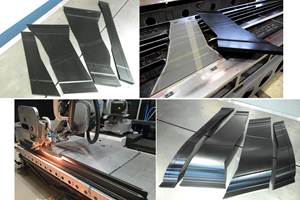McLaren develops aerospace-inspired ART method for volume composite super car engineering
Automated rapid tape (ART) technique, already deployed at the MCTC and to be used for future McLaren models, is capable of producing lighter, stiffer and stronger carbon fiber structures with less waste.
Aerospace industry-grade carbon fiber comes to super cars with McLaren ART carbon fiber. Source (All Images) | McLaren Automotive
McLaren Automotive (Woking, Surrey, U.K.) announces that it has developed a “world-first” manufacturing method that scales an aerospace-inspired carbon fiber production process for volume super car manufacturing. The specialized manufacturing process, called automated rapid tape (ART), will be used to enhance McLaren’s future car models.
McLaren Automotive produces ultra-high performance, lightweight super cars. Launched in 2010, the company is now the largest part of the McLaren Group, combining more than four decades of experience in exploiting the benefits of carbon fiber as a weight, performance and structural strength enabler both in racing and automotive. McLaren says that every vehicle it has ever made has been based on a carbon fiber monocoque.
The ART method was inspired by the aerospace industry’s ability to use ultra-precise manufacturing methods to build tailored carbon fiber structures, which is often achieved via robotic deposition of composite tapes. McLaren notes that the aerospace industry’s process is a more rapid, high-rate version of the ART method, however.
ART, now integrated into the McLaren Composites Technology Centre (MCTC), employs a specially designed machine using a fixed deposition head and a rapidly moving bed capable of rotation to unlock a faster manufacturing process suitable for automotive purposes and high-rate composites manufacturing. It enables tailored fiber placement in order to create new possibilities relating to load bearing or stiffness requirements not possible by conventional hand-laid methods. ART also encourages innovation by freeing engineers from uniform material constraints. Specific adjustment of fiber orientation within the composite material allows for anisotropic stiffness — rigidity can be enhanced in specific directions while flexibility can be maintained elsewhere. This unlocks new ways to design highly loaded, complex aerodynamic components that can also be made visually distinct.
In addition, McLaren says the process enables optimized strength-to-weight ratios; fibers can be concentrated in areas subject to high stress or load, such as joints, edges or connection points, in turn allowing for the removal of unnecessary material in low-stress regions.
As measured lengths of dry composite tape are laid down when building out a part made of McLaren ART carbon fiber, there is reported to be a significant reduction in the generation of irregular-shaped off-cuts that cannot be reused. Up to 95% of the raw dry tape material used to layer a component goes into the final part. The automated process also reduces positioning inaccuracies and material loss caused by human error, ensuring that the final layup is within design tolerances, in turn minimizing rejected parts. The automated element of ART also provides real-time monitoring and control, ensuring consistent process parameters and optimized part quality.
ART’s delivery of reduced manufacturing time and costs creates the possibility of greater use of carbon fiber in more areas of a vehicle, McLaren says. Looking beyond the carbon fiber tub, wider use of ultra-lightweight body panels, for example, constructed of McLaren ART carbon fiber, become more feasible and cost-effective.
A prototype high-rate deposition machine has already been installed at MCTC. McLaren says the first installation of ART will be upscaled to an industrial-spec machine later in 2025, with increased manufacturing capacity.
The first McLaren vehicles to feature McLaren ART carbon fiber will be the McLaren Ultimate super car and the next car in “1” car linage, the McLaren W1. The fixed plane within the active front wing assembly, an integral part of the car’s aerodynamic package that can generate up to 1,000 kilograms of downforce, benefits from McLaren ART’s increased stiffness, with up to 10% higher stiffness than a comparable pre-impregnated part. Further components made from ART carbon fiber are under consideration for production examples of the W1.
Related Content
Plant tour: Airbus, Illescas, Spain
Airbus’ Illescas facility, featuring highly automated composites processes for the A350 lower wing cover and one-piece Section 19 fuselage barrels, works toward production ramp-ups and next-generation aircraft.
Read More3D-printed CFRP tools for serial production of composite landing flaps
GKN Aerospace Munich and CEAD develop printed tooling with short and continuous fiber that reduces cost and increases sustainability for composites production.
Read MoreManufacturing the MFFD thermoplastic composite fuselage
Demonstrator’s upper, lower shells and assembly prove materials and new processes for lighter, cheaper and more sustainable high-rate future aircraft.
Read MoreCombining multifunctional thermoplastic composites, additive manufacturing for next-gen airframe structures
The DOMMINIO project combines AFP with 3D printed gyroid cores, embedded SHM sensors and smart materials for induction-driven disassembly of parts at end of life.
Read MoreRead Next
Roboze supports F1 composite brake cooling duct manufacture
Carbon fiber-reinforced PEEK composites, 3D printing services improve production time and costs of complex motorsport parts for Visa Cash App RB F1 team.
Read MoreMcLaren Automotive opens new carbon fiber innovation and production center
McLaren Composites Technology Centre (MCTC) will focus on innovating lightweight carbon fiber and composites for improved energy efficiencies in automobiles.
Read MoreMcLaren maximizes composites use with release of Artura Spider
The supercar has been designed and developed to meet ambitious targets with the incorporation of McLaren’s MCLA architecture, even sporting a composite retractable hard-top.
Read More




























